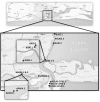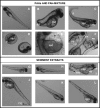Lagos lagoon sediment organic extracts and polycyclic aromatic hydrocarbons induce embryotoxic, teratogenic and genotoxic effects in Danio rerio (zebrafish) embryos
- PMID: 27068906
- PMCID: PMC4943991
- DOI: 10.1007/s11356-016-6490-y
Lagos lagoon sediment organic extracts and polycyclic aromatic hydrocarbons induce embryotoxic, teratogenic and genotoxic effects in Danio rerio (zebrafish) embryos
Abstract
An expansion of anthropogenic activity around Lagos lagoon, Nigeria, has raised concerns over increasing contaminants entering the lagoon's ecosystem. The embryotoxicity, teratogenicity and genotoxicity of sediment organic extracts from four sampling zones around Lagos lagoon, Ilaje, Iddo, Atlas Cove and Apapa, as well as the dominant polycyclic aromatic hydrocarbons (PAHs) identified in water measured during the wet season (naphthalene, phenanthrene, pyrene, benzo[a]pyrene and a mixture of these), were assessed with Danio rerio embryos. Embryos were exposed to varying concentrations of toxicants from 0-72 h post-fertilization (hpf). Embryotoxicity at 72 hpf showed a dose-dependent increase in mortality upon exposure to extracts from all zones, except Atlas Cove. Similarly, higher levels of teratogenic effects, such as increased oedema, and haemorrhage and developmental abnormalities resulted from exposure to extracts from Ilaje, Iddo and Apapa zones. Treatment with single PAHs revealed that significant levels of detrimental effects were obtained only for phenanthrene. The modified comet assay revealed that the oxidative damage to DNA was generally low (<12 %) overall for all sediment extracts, but was significantly elevated with Ilaje and Iddo sediment extracts when compared with solvent controls. Oxidative damage was observed with the single PAHs, phenanthrene and benzo[a]pyrene, as well as with the PAH mixture. This study highlights that Lagos lagoon sediment extracts have teratogenic, embryotoxic and genotoxic properties, which are likely due to the high molecular weight PAHs present in the extracts, some of which are known or are suspected human carcinogens.
Keywords: Embryotoxicity; Genotoxicity; Lagos lagoon; Sediment; Teratogenicity; Zebrafish embryos.
Figures





 )
)Similar articles
-
Specific polycyclic aromatic hydrocarbons identified as ecological risk factors in the Lagos lagoon, Nigeria.Environ Pollut. 2019 Dec;255(Pt 2):113295. doi: 10.1016/j.envpol.2019.113295. Epub 2019 Sep 20. Environ Pollut. 2019. PMID: 31563786
-
Sawmill Activities Near the Lagos Lagoon, Nigeria: Polycyclic Aromatic Hydrocarbons and Embryotoxic Evaluations of Sediment Extracts Using Clarias gariepinus.Bull Environ Contam Toxicol. 2020 Jun;104(6):809-819. doi: 10.1007/s00128-020-02845-6. Epub 2020 Apr 20. Bull Environ Contam Toxicol. 2020. PMID: 32313984
-
Cytotoxic and genotoxic responses of the RTgill-W1 fish cells in combination with the yeast oestrogen screen to determine the sediment quality of Lagos lagoon, Nigeria.Mutagenesis. 2015 Jan;30(1):117-27. doi: 10.1093/mutage/geu032. Mutagenesis. 2015. PMID: 25527734
-
Assessing contamination levels of Laguna Lake sediments (Philippines) using a contact assay with zebrafish (Danio rerio) embryos.Sci Total Environ. 2005 Jul 15;347(1-3):254-71. doi: 10.1016/j.scitotenv.2004.12.002. Sci Total Environ. 2005. PMID: 16084981
-
DNA damage induced by genotoxicants in zebrafish (Danio rerio) embryos after contact exposure to freeze-dried sediment and sediment extracts from Laguna Lake (The Philippines) as measured by the comet assay.Mutat Res. 2008 Jan 31;650(1):1-14. doi: 10.1016/j.mrgentox.2007.09.009. Epub 2007 Oct 23. Mutat Res. 2008. PMID: 18069050
Cited by
-
Spatial distribution of benthic foraminifera in the Lagos Lagoon (Nigeria): Tracing the impact of environmental perturbations.PLoS One. 2020 Dec 7;15(12):e0243481. doi: 10.1371/journal.pone.0243481. eCollection 2020. PLoS One. 2020. PMID: 33284843 Free PMC article.
-
Co-exposure to polystyrene plastic beads and polycyclic aromatic hydrocarbon contaminants in fish gill (RTgill-W1) and intestinal (RTgutGC) epithelial cells derived from rainbow trout (Oncorhynchus mykiss).Environ Pollut. 2019 May;248:706-714. doi: 10.1016/j.envpol.2019.02.066. Epub 2019 Feb 22. Environ Pollut. 2019. PMID: 30849588 Free PMC article.
-
Biomonitoring, physico-chemical, and biomarker evaluations of abattoir effluent discharges into the Ogun River from Kara Market, Ogun State, Nigeria, using Clarias gariepinus.Environ Monit Assess. 2018 Dec 28;191(1):44. doi: 10.1007/s10661-018-7168-3. Environ Monit Assess. 2018. PMID: 30593602
-
Screening of the Toxicity of Polystyrene Nano- and Microplastics Alone and in Combination with Benzo(a)pyrene in Brine Shrimp Larvae and Zebrafish Embryos.Nanomaterials (Basel). 2022 Mar 12;12(6):941. doi: 10.3390/nano12060941. Nanomaterials (Basel). 2022. PMID: 35335754 Free PMC article.
-
Sorption Processes of Selected PAHs on Selected Fire-Resistant Materials Used in Special Firefighter Clothing.Materials (Basel). 2024 Apr 10;17(8):1741. doi: 10.3390/ma17081741. Materials (Basel). 2024. PMID: 38673098 Free PMC article.
References
-
- Ajagbe FE, Osibona AO, Otitoloju AA. Diversity of the edible fishes of the Lagos Lagoon, Nigeria and the public health concerns based on their Lead (Pb) content. Int J Fisheries Aquaculture. 2012;2:55–62.
-
- Ajao EA, Fagade SO. Study of the sediments and communities in Lagos lagoon, Nigeria. Oil Chem Pollut. 1990;7:85–117. doi: 10.1016/S0269-8579(05)80017-6. - DOI
-
- Alani R, Drouillard K, Olayinka K, Alo B. Bioaccumulation of polycyclic aromatic hydrocarbons in fish and invertebrates of Lagos lagoon, Nigeria. JETEAS. 2012;3(2):287–296.
-
- Albertini RJ, Anderson D, Douglas GR, Hagmar L, Hemminki K, Merlo F, Natarajan AT, Norppa H, Shuker DEG, Tice R, Waters MD, Aitio A. IPCS guidelines for the monitoring of genotoxic effects of carcinogens in humans. Mutat Res – Rev Mutat. 2000;463:111–172. doi: 10.1016/S1383-5742(00)00049-1. - DOI - PubMed
-
- Al-Subiai SN, Arlt VM, Frickers PE, Readman JW, Stolpe B, Lead JR, Moody AJ, Jha AN. Merging nano-genotoxicology with eco-genotoxicology: an integrated approach to determine interactive genotoxic and sub-lethal toxic effects of C(60) fullerenes and fluoranthene in marine mussels, Mytilus sp. Mutat Res. 2012;745:92–103. doi: 10.1016/j.mrgentox.2011.12.019. - DOI - PubMed
MeSH terms
Substances
Grants and funding
LinkOut - more resources
Full Text Sources
Other Literature Sources

